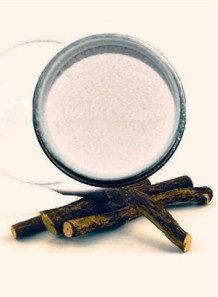Glycyrrhizic acid (Oil Soluble Licorice Extract)
- Product Code: 127336
widely studied for its beneficial effects when applied topically. In skincare formulations
widely studied for its beneficial effects when applied topically. In skincare formulations
Glycyrrhizic acid (and its active metabolite, glycyrrhetinic acid) is widely studied for its beneficial effects when applied topically. In skincare formulations, its benefits include:
-
Anti‐inflammatory Activity
Glycyrrhizic acid helps reduce skin inflammation by inhibiting pro‐inflammatory mediators such as tumor necrosis factor‑α (TNF‑α) and interleukin‑1α, and by modulating pathways such as NF‑κB. This action can soothe irritated skin and is beneficial in conditions such as psoriasis and eczema.
• For example, a study using a glycyrrhizic acid compound ointment in a mouse model of psoriasis reported significant improvement in inflammation and reduction in cytokine levels (DOI: 10.1371/journal.pone.0290637). -
Antioxidant Protection
By upregulating antioxidant enzymes (e.g., heme oxygenase‑1) and inhibiting lipid peroxidation, glycyrrhizic acid can protect skin cells from oxidative stress induced by ultraviolet radiation and environmental pollutants. This antioxidant effect helps prevent premature aging and maintains the skin’s overall health.
• A review focusing on the dermatological applications of 18β‑glycyrrhetinic acid (the active form) outlines these antioxidant benefits (DOI: 10.1111/ics.12548). -
Antimicrobial Effects
Glycyrrhizic acid exhibits antimicrobial activity against a range of skin pathogens (including strains of Staphylococcus aureus). This property can help reduce the risk of infection in compromised skin and may be useful in managing acne or other bacterial skin conditions. -
Skin Brightening and Anti‑pigmentation
Topically, glycyrrhizic acid has been shown to inhibit tyrosinase—the key enzyme in melanin synthesis—thereby reducing hyperpigmentation and promoting a more even skin tone. Although some studies report varying effects on melanogenesis, its inclusion in brightening formulations is supported by its melanin‑dispersion activity. -
Anti‑aging Benefits
In addition to its antioxidant effects, glycyrrhizic acid can help slow the degradation of collagen by reducing the activity of matrix metalloproteinases (MMP‑1 and MMP‑3). This action contributes to maintaining skin firmness and reducing the appearance of fine lines and wrinkles.
Additional supportive evidence comes from a comprehensive review of the pharmacological effects of Glycyrrhiza species, which details these multiple mechanisms of action (DOI: 10.1002/ptr.5487). Furthermore, research by Kao and colleagues demonstrated that glycyrrhizic acid inhibits inflammatory signaling via the PI3K/Akt/GSK3β pathway and glucocorticoid receptor activation (DOI: 10.1021/jf101841r).
How to mix: Mix in the oil. Can melt at room temperature But if you use heat of 40-50 degrees to help dissolve it, it will dissolve easily and faster.
Usage rate: 0.1-1.0%
Product appearance: White or light yellow powder
Solubility: Can be dissolved in oil.
Storage: For long-term storage Store in the refrigerator, tightly closed, away from light. At least 2 years old
INCI Name : Glycyrrhizic acid
| Mechanism | - |
| Appearance | - |
| Longevity | - |
| Strength | - |
| Storage | - |
| Shelf Life | - |
| Allergen(s) | - |
| Dosage (Range) | - |
| Recommended Dosage | - |
| Dosage (Per Day) | - |
| Recommended Dosage (Per Day) | - |
| Mix Method | - |
| Heat Resistance | - |
| Stable in pH range | - |
| Solubility | - |
| Product Types | - |
| INCI | - |
Purchase History for
Cart
No products



